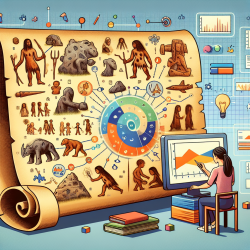Introduction
The field of speech-language pathology is ever-evolving, with new research constantly reshaping our understanding of how best to support children's communication development. One such avenue of research is the study of human paleodemography and paleoecology, which provides insights into historical population dynamics and their implications for modern practices. The recent study titled "Human Paleodemography and Paleoecology of the North Pacific Rim from the Mid to Late Holocene" offers valuable lessons that can be translated into speech-language therapy, particularly in the context of online therapy services like those provided by TinyEYE.
Understanding Paleodemographic Patterns
The study by Fitzhugh et al. (2024) explores the dynamic population changes in the North Pacific Rim over the last 5000 years, highlighting the influence of ecological and climatic factors on human populations. By employing advanced statistical methods such as the Time Iterative Moran I (TIMI) spatial autocorrelation, the researchers were able to identify patterns of population growth and decline, providing a framework for understanding how environmental changes impact human societies.
Implications for Speech-Language Pathology
While the direct connection between paleodemography and speech-language therapy may not be immediately apparent, the underlying principles of adaptation and resilience are highly relevant. Here are a few ways these insights can be applied:
- Data-Driven Decision Making: Just as paleodemographers use data to understand past human behaviors, speech-language pathologists can leverage data to tailor therapy plans. By analyzing patterns in therapy outcomes, practitioners can identify effective strategies and adjust interventions accordingly.
- Environmental Adaptation: Understanding how historical populations adapted to environmental changes can inspire therapists to consider the broader context of a child's environment. This might include adapting therapy to suit the child's home setting, especially in online therapy scenarios.
- Resilience Building: The study highlights the resilience of human populations in the face of ecological shifts. Similarly, speech-language therapists can focus on building resilience in children, helping them develop coping strategies for communication challenges.
Encouraging Further Research
The study opens up avenues for further research in speech-language pathology. Practitioners are encouraged to explore how historical insights can inform modern therapy techniques, particularly in understanding the role of environmental factors in communication development. Collaborations with researchers in fields like anthropology and ecology could lead to innovative approaches in therapy.
Conclusion
By integrating insights from paleodemography into speech-language therapy, practitioners can enhance their understanding of how environmental and historical factors influence communication development. This holistic approach not only improves therapy outcomes but also aligns with the data-driven ethos of modern speech-language pathology. To read the original research paper, please follow this link: Human Paleodemography and Paleoecology of the North Pacific Rim from the Mid to Late Holocene.










